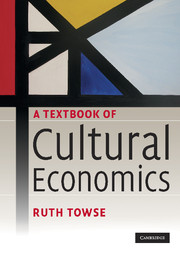Book contents
- Frontmatter
- Contents
- List of figures
- List of tables
- List of boxes
- List of abbreviations
- Preface
- Part I General issues in cultural economics
- Part II The ‘traditional’ economics of the arts and heritage
- Part III Artists' labour markets and copyright
- Part IV The creative industries
- Introduction
- 14 Economics of creative industries
- 15 Economics of the music industry
- 16 Economics of the film industry
- 17 Economics of broadcasting
- 18 Economics of book publishing
- 19 Economics of festivals, creative cities and cultural tourism
- Part V Conclusion and exercises and problems
- References
- Index
19 - Economics of festivals, creative cities and cultural tourism
- Frontmatter
- Contents
- List of figures
- List of tables
- List of boxes
- List of abbreviations
- Preface
- Part I General issues in cultural economics
- Part II The ‘traditional’ economics of the arts and heritage
- Part III Artists' labour markets and copyright
- Part IV The creative industries
- Introduction
- 14 Economics of creative industries
- 15 Economics of the music industry
- 16 Economics of the film industry
- 17 Economics of broadcasting
- 18 Economics of book publishing
- 19 Economics of festivals, creative cities and cultural tourism
- Part V Conclusion and exercises and problems
- References
- Index
Summary
This final chapter of Part IV attempts to pull together a rather scattered literature on several related topics on which cultural economics has something to say: festivals, creative cities and cultural clusters, and cultural tourism. While they are not new topics in cultural economics – in fact, festivals were a relatively early topic – they have not been analysed together in a textbook treatment, and lately they have been more the concern of economic and cultural geographers and urban planners than of economists. They call on some of the most basic concepts of cultural economics, however: the social benefits of the arts and culture, their economic impact, the evaluation of cultural policy, and so on.
As with all economic topics, there is a supply side and a demand side, and each calls for its own analysis. On the supply side, festivals provide a city or other location with an image and cultural identity, often fostered by the local or regional administration and subsidised by them, and they cause external production economies (spillovers) for the tourist trade by attracting visitors. Cultural facilities may also attract non-cultural businesses, and the facilities and aura of cultural activity attract creative people and enterprises; there may also be a policy of promoting cities as creative hubs in line with this image. The European Union's policy of designating Cities of Culture (now European Capitals of Culture), for which cities compete, and UNESCO's cultural heritage listing, which includes ‘heritage’ cities, attract tourism.
- Type
- Chapter
- Information
- A Textbook of Cultural Economics , pp. 513 - 536Publisher: Cambridge University PressPrint publication year: 2010



